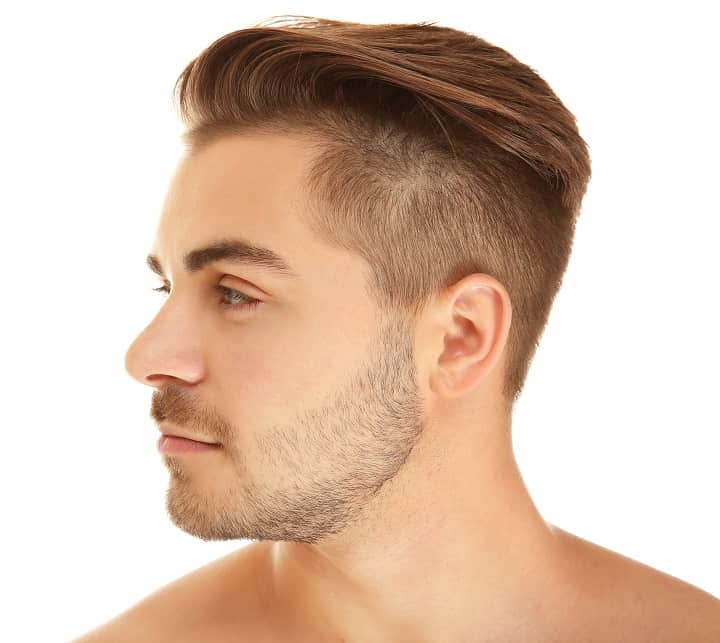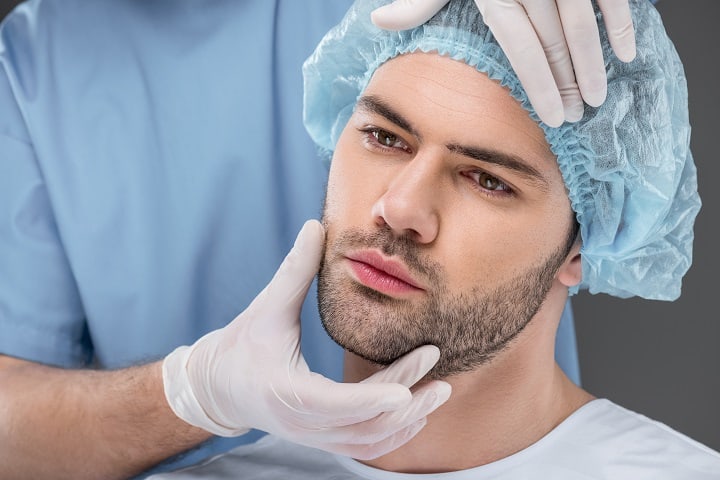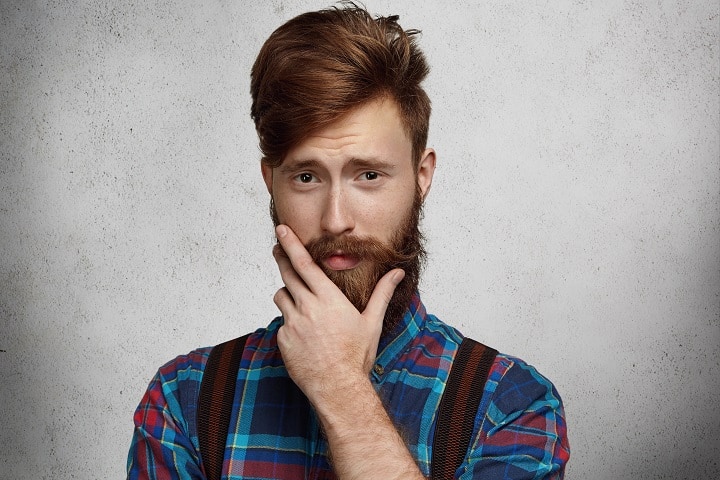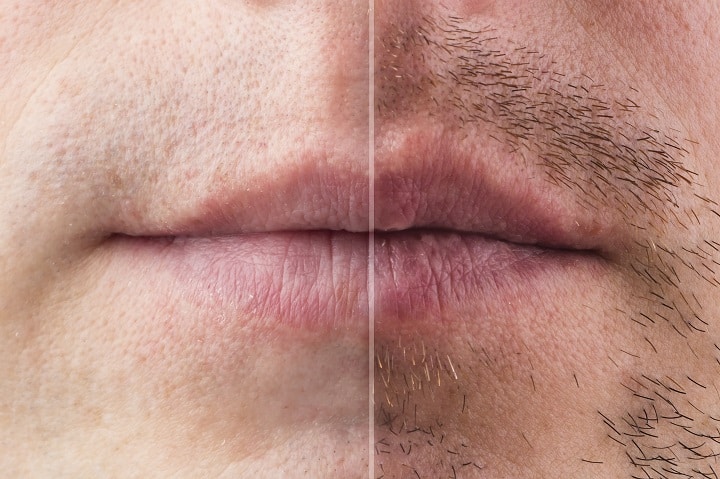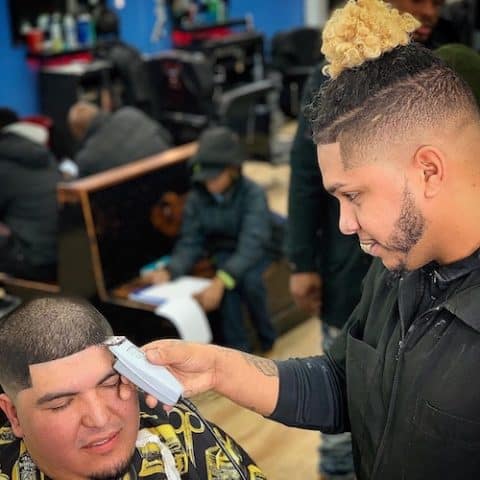Although there are many natural, proven ways to enhance beard growth even when you didn’t hit the genetic jackpot, for some men it seems that nothing works.
If you’re one of them, you’ve probably tried every advice, tip and hack known to humankind, read all the articles about how to grow a beard if you can’t, but to no avail.
Not even a single hair has grown on your face. You’ve probably felt defeated more times than you can count.
Don’t give up just yet! If your body can’t grow a beard and every other tactic has failed you, beard transplants are the way to go for you.
Since we know you’re not sure exactly sure what beard transplants are how they can help you, we’ve made sure to write a complete guide so you can make an informed decision.
From the cause of no facial hair growth to the cost and process of the procedure to its lasting effects and possible alternatives, we’re covering all the bases.
Table Of Contents
- Why Does Your Beard Look Patchy
- What is a Beard Transplant
- How Much Does a Beard Transplant Cost
- Types
- Beard Transplant Process – Before, During, After and Side Effects
- Differences Between Hair and Beard Transplant
- Can You Be a Beard Donor
- Possible Side Effects
- Is It Permanent
- What Are The Alternatives
- Maintaining Your New Beard
- FAQ
Why Does Your Beard Look Patchy
If your beard is lacking in the thickness department or you’re tired of seeing weak patches of hair in your beard, you could be a good candidate for a beard transplant.
While too many men get defeated by these patches, it’s not a roadblock that can’t be conquered.
Growing a beard naturally might not be in the cards for you, but the innovations in the medical and aesthetics world have made this possible with the help of beard transplants.
If you’re dealing with a thin or patchy beard, though, you’d probably like to know why.
It might be hard to pinpoint it to just one thing, but there are a number of common reasons a man might be sealed with this fate:
Hormones
Hormones are a good place to start when looking for the “why” of patchy facial hair.
They’re often the key players here. Some men have improper or weak blood flow to the cheeks.
While this might not seem immediately related to hormones, we promise it is.
You see, with less blood flowing in the area, there’s fewer nutrients and hormones there as well.
Some of these hormones might be beard-growing hormones, but since it’s not properly reaching the facial hair area, you won’t see the results.
The two main hormones at work here are testosterone and dihydrotestosterone.
Testosterone, the main hormone that gets men through puberty, is also a key player in beard growth.
A lower level of testosterone may make it more difficult.
Dihydrotestosterone is created by beard follicles from regular testosterone, but if there’s not a lot of testosterone to work with, the DHT is also on the lower end of the spectrum.
This is important because it regulates male characteristics, like beards.
Genetics
A big factor of beard growth comes from your father and your father’s father.
Just like tall parents usually mean tall children, a big beard can run in the family just as lack of beard growth can, too.
Genetics is something we can’t control much. We get what we get.
Alopecia
Alopecia Areata is a condition that most men won’t suffer from, but if you’re trying to pinpoint the cause of a patchy beard, it’s something to consider.
If you experience spot baldness in other areas such as your scalp, that might be a sign.
Luckily, this condition is completely treatable (and you might even see it go away all on its own!).
Lifestyle
While not the biggest player in the game, lifestyle factors can also influence the growth and flourishing of your body, beard included.
Things, like not getting enough sleep, enduring excessive amounts of stress and not working out enough, could all be connected to a patchy beard.
Luckily, all of these things are in your control!
With supplements and vitamins, a healthy diet and an exercise regimen, you can give your beard at least a fighting chance against the other odds stacked against it.
What is a Beard Transplant
Essentially, a beard transplant is what it sounds like.
Healthy, thick hair that has flourished elsewhere on your body is removed and transplanted hair is brought to the beard area of the face, allowing it to harvest on the face and continue growing like a normal hair follicle.
The hair usually comes from a hidden area on the patient’s head for consistency’s sake.
Once the surgeon removes the healthy hair follicles from the donor area, he implants them back into the skin of the beard area so they can harvest and create new growth.
He must be careful to implant them at natural angles of the hair, so it reflects the original hair growth pattern.
In average hair transplants, you can get about 4,000 to 7,000 follicles grafted onto the beard.
A lot of the time, though, only about 2,500 follicles are necessary for a full beard.
Sometimes in order to mimic the thickness and fullness of normal beards, hair transplant surgeons will use two hair-grafts instead of individual ones.
So, why should you consider a beard transplant?
Here are some of the pros of going for the procedure:
PROS
According to several studies, beards are attractive to women for a number of reasons. These include:
- Beards imply security and strength. Studies show that beards can make men seem stronger and more capable of providing security.
- Beards imply intelligence. Hemingway, Einstein, need we say more? The historical presence of beards on intelligent men is notable.
- Beards imply a balance of edginess and sensitivity. Beards somehow exude of a combination of both “toughness” and sensitivity.
- Beards imply confidence. Not only do beards imply confidence from the perspective of the viewer, but they also instill confidence in the beard-haver.
This boost of confidence helps you feel secure in yourself and your looks.
Beard transplants aren’t very painful.
While reading the description of the procedure might not sound fun, the reality is that its’ virtually pain-free due to the minimal invasion and innovations in medicine.
The worst discomfort you may feel is a small pinch.
Beard transplants actually aren’t limited to just the lower facial area.
You aren’t limited to the beard area with a beard transplant, in fact.
You can have hair grafted onto eyebrows, sideburns or just about anywhere else where you’re experiencing hair loss with consultation from your doctor.
Beard transplants don’t require very much recovery time.
Other than light redness or swelling a few days following the transplant, there are virtually no side effects.
A procedure usually takes about 5 hours and is an inpatient procedure that will send you home right after.
It acts as a normal beard. After the transplant fully heals, it should grow and act just like normal hair.
You’ll be able to grow your beard faster, style and trim it as normal! That’s the whole point.
CONS
Of course, with every medical procedure, there are a few downsides.
Usually, these are minimal with beard transplants, however, that it’s worth the investment and value to those who receive it!
It’s not cheap.
Beard transplants might put a strain on the wallet, which makes some men too intimidated to try it.
Saving up is a good idea to make it more affordable and some offices may even be able to offer a payment plan to make it feasible for you.
You’ll have to donate hair from other parts of your body.
Most of the time, the hair that is harvested into the beard area is donated from another spot on the same person’s body.
It usually comes from the back of the scalp, since that hair is closest to the texture of facial hair.
The hair has to come from somewhere, and it looks most natural if it comes from the same person.
A few hidden spots in the back of the head doesn’t show much, and it’s usually worth it for the nice, full beard.
Your originally transplanted hairs will fall out about 3 weeks after the procedure.
A natural side effect (and about the only one) of the procedure is initial hair shedding and hair loss in some patchy areas.
While the originally harvested hairs will fall out, there’s no need to worry.
At this point, it has fully implanted the new hair follicle and new, transplanted hairs will begin to grow.
Your doctor should be able to help you understand the time frame of re-growth, but don’t worry, it will come back!
It’s just a part of the process to get a thick new beard.
How Much Does a Beard Transplant Cost
Now that you understand the detailed process of what a beard transplant is, it’s probably no surprise that it’s an expensive procedure.
Then again, when you compare this treatment to other aesthetic procedures we partake in as humans in order to enhance our looks and feel better about ourselves, it’s not out of place.
If having a thick and healthy beard is important to you, you should never feel bad about the decision to undergo a beard transplant.
While the total cost isn’t the most important thing, it’ll be well worth the investment to be happy with what you see in the mirror every morning.
Depending on the clinic and the doctor you end up choosing, you should be prepared to pay anywhere from $5,000 to $15,000 for a quality beard transplant.
It’s definitely possible to find cheaper options elsewhere, but for a procedure performed by a reputable clinic that has produced successful results, you won’t want to pay much less than this.
Charges will vary at each clinic you check out.
Prices may be affected by grafts needed, sessions required and consultations fees, among others.
Some clinics will charge by how many facial grafts you need (usually the most effective price model), while some will charge by the number of sessions needed to complete the transplanted hairs process.
Others may charge a hefty initial consultation fee, which may be avoided by doing research ahead of time.
You may also incur extra costs from a possible dermatologist visit (to determine the cause of patchiness) or recovery materials.
While this does work out to be a pretty expensive ordeal, it’s an investment.
Spending a lower amount will only result in shoddy work, short-lived results or unhappiness with the final result.
You want your beard to be in the best hands and you get what you pay for.
Types
There are two major kinds of beard transplants:
- Follicular Unit Extraction (also known as FUE)
- Follicular Unit Transplantation (FUT)
While each is a bit different, both involve the same process of a surgeon removing the hair from the donor area.
Let’s learn a bit about the two options:
FUE
FUE is the most common type of beard transplant.
In this process, individual hairs are grafted from the donor area (one by one) and then harvested over a much larger area.
What’s left in the donor area are just small, white circular scars around the follicles. (Results may vary depending on the doctor and clinic.)
FUT
In a FUT transplant, a small strip of tissue is taken from the donor area through the process of microscopic dissection.
Left behind is just one small fine scar from the closed wound.
Here’s a quick comparison of the advantages of the two options:
Advantages of FUE
- No linear scar
- Faster time of healing
- Quicker return to physical activity
- Facial scars difficult to detect
- Little to no discomfort
Advantages of FUT
- One small linear scar
- Harvests a larger amount of hair
- Uses mid-portion of harvest zone to increase the number of grafts in the one used area
As you can see, in almost all cases the FUE procedure comes out on top.
Beard Transplant Process – Before, During, After and Side Effects
Now that you’re on board with the two types of beard transplants let’s get into the procedure itself.
We’re going to walk you through the preoperative period, the procedure itself, and the postoperative period to full recovery.
Let’s get started!
Pre-Procedure
Before the transplant, there are a few precautions the patient will need to take.
This includes avoiding aspirin, anti-inflammatory medication and alcohol for at least 10 days prior to the transplant.
There are also a few things to add to a daily routine before getting a beard transplant performed:
- Taking a Vitamin C tablet every day, for example, will help with the healing process and during the recovery period.
- Twelve hours prior to the surgery, the patient should avoid caffeine in tea or coffee because it may increase their bleeding or sensitivity to medicine after the treatment.
During the Procedure
Depending on the procedure you chose, the experience will be different. The two procedures are described above.
We’ll cover the FUE procedure more in-depth here, as it is the most common procedure used.
During the FUE method, both the donor area and the harvesting area will be numbed with a short-acting and long-acting local anesthetic.
This will minimize any discomfort, but the patient may still feel slight pinching during the administering of the transplant.
Once the patient is numb, the doctor then begins the grafting procedure.
He’ll cut out the individual hair follicles and implant them into the facial areas where you desire the hair to grow.
After the Procedure
Immediately after the local anesthesia wears off, the patient may feel a tightness to replace the numbness.
There might be slight redness, irritation or discomfort on the first night after the procedure.
You can ask your doctor for pain medication or simply use over-the-counter anti-inflammatory medication.
The next morning, the patient should feel fine aside from a slight bit of numbness in both areas.
This will be the long-acting anesthesia wearing off.
The patient may even experience slight numbness for a few months after the procedure, but it won’t be painful.
Differences Between Hair and Beard Transplant
Many people are under the impression that a hair transplant and a beard transplant are the same things.
While they do have similar characteristics, the main differences are the type of hair and skin used for both donation and harvesting.
Hair Growth Factors
One point is that hair growth and beard growth are controlled by different forces.
When it comes to beard growth, it’s powered by the hormone androgen from the time of puberty onward for about 20 years, growing in density the whole time.
Scalp hair, on the other hand, may begin to fall out in male-pattern baldness when there’s too much androgen.
These scalp follicles are also more sensitive to certain hormones, which may cause them to fall out.
Beard growth and density are also affected by ethnicity in some cases.
For example, those with Middle Eastern and Indian backgrounds are more prone to thick facial hair and beards, white and black men have moderate facial hair and Asian men tend to have the least facial hair.
Procedure Planning
The planning for the doctor is pretty similar with both procedures.
For a hair transplant, the doctor must inspect the scalp to estimate the number of grafts that will be needed.
For a beard or facial hair transplant, the doctor will need to inspect the entire face and neck to estimate the grafts needed.
Any other preparation information will be given to you by your doctor at the consultation or pre-operation appointment.
Be sure to ask about any concerns you may have.
The Procedure Itself
The donor area is usually a bit different for hair and beard transplants.
For beard transplants, the donor area is usually on the back of the head, in a low, hidden area.
For scalp hair transplants, the hair may come from the back of the head if there is enough to graft.
If there’s not enough to graft, it may be taken from somewhere else on the body like the chest or legs.
It all depends on how severe the baldness is.
As far as the incisions go, the tiny incisions on your face in a beard transplant will be much smaller and less noticeable since your face is a much more frequently viewed area than the top of your head is.
Similarities
Besides these two aspects of the procedure and the difference in time (a hair transplant usually takes much longer), everything else about the two treatments is pretty similar.
Both will produce long-lasting results.
After initial hair shedding, you’ll have continuously growing hair that’s lush and can be treated and styled just like normal hair.
Can You Be a Beard Donor
If the question is whether or not you can donate hair to be used for another person’s beard transplant, the answer is no.
There are a number of reasons why this is not an approved or recommended treatment.
The main reason is because of rejection.
Even if the donor’s hair comes from someone the patient is related to, it’s still very likely that the organs will reject the foreign hair follicle because they will not recognize it as their own. (The only exception to this is identical twins.)
The way to avoid rejection is by taking strong immunosuppressant drugs for the rest of their lives and that’s not very sustainable for something as minor as a beard transplant.
It also requires a lifelong medical regimen that includes several doctors constantly monitoring your health, a full lifestyle change that requires utmost health and immunity, drug aversion due to possible negative reactions and restrictive diets.
Possible Side Effects
If all of that still weren’t enough to deter you, there are a number of unpleasant side effects from the immunosuppressant drugs themselves.
This long list includes, but is not limited to:
- Lowered levels of blood counts
- Elevated levels of blood sugar
- Elevated levels of cholesterol
- High blood pressure
- Irritable bowel or diarrhea
- Headaches
- Swelling or tingling in the extremities
- Nausea
- Tremors or shaking
- Osteoporosis
- Improper healing of wounds
It even carries a side effect of hair loss!
So, going through the whole procedure just to have the hair fall back out due to the medicine necessary to remain healthy… isn’t worth it.
It could also trigger something like reverse immunity in which your body recognizes the new follicles as foreign and invasive and will essentially create a war between your skin in that area and the new hair.
Is It Permanent
A beard transplant is the most permanent solution available for beard loss.
Just as a hair transplant creates permanent hair solutions for a balding head, a beard transplant can also help create a permanent solution for a patchy beard.
When the new hair initially falls out, that means the hair follicle has been successfully implanted.
From that point on, new hair will continue to grow from that follicle and can be treated just like any other hair.
The only difference that should be noted here is that the characteristics of the hair that’s donated will remain present even when growing from the new harvesting spot.
That is to say that the texture, curl pattern and density will remain what it was before being harvested.
Thin body hair transplanted on a beard area will not grow back thick like normal facial hair.
Instead, it will continue to grow like thin body hair. Curly chest hair will not straighten out on a balding head either.
With that in mind, using hair that has the closest set of characteristics to that of the beard hair will create a seamless finished look.
For example, using body hair for sideburn or temple implants may help fade out the hairline without looking too drastic.
Using thick chest hair may work for someone with a curly beard or they may be able to blend the texture in with their natural facial hair.
What Are The Alternatives
If you’ve gotten this far and are still unsure about whether or not a beard transplant is right with you, you might want to bring some alternative options into consideration.
Whether due to budget constraints or other reasons, there are a few additional treatment options that might work better for you.
Minoxidil
The most common product specifically for hair growth is called Minoxidil.
Also known as Rogaine, this ingredient has FDA approval and has helped many men achieve the thickness of hair that they desire.
While it doesn’t provide a permanent solution like a beard transplant would, it’s a good temporary option.
While doctors aren’t totally sure how this ingredient creates hair growth and how it causes facial hair restoration, this is what they do know.
Originally, Minoxidil was intended to lower blood pressure. Hair growth was a side effect.
When scientists discovered that it promoted better blood circulation in the follicles and stimulated hair growth through the influx of nutrients and hormones that blood provided, they began using it for the main purpose of hair regrowth and hair restoration.
There are three phases of hair growth: Anagen, Catagen, and Telogen.
Minoxidil prolongs the first phase, Anagen, which is the phase in which hair actually grows.
When an Anagen phase is too short, there won’t be enough production of hair.
Minoxidil also encourages the stimulation of prostaglandin synthase-1, an enzyme, through the immune system.
Hair loss has, for a while, been linked to changes in the immune system.
This production of prostaglandin synthase-1 can reverse the negative effects caused by a poorly functioning immune system.
If you’re interested in Minoxidil, you should consider which of the two forms will work best for you.
Minoxidil Foam is the most popular form of treatment for hair loss.
It’s much more expensive than the liquid form (twice as much, actually) but it dries twice as fast.
You’re essentially paying more for the convenience of speed and efficiency. If this sounds like a worthwhile trade-off, this might be the route to take.
Minoxidil Liquid is the original formula of Rogaine that was first used to treat hair loss.
This liquid takes twice as long as the foam to dry, as mentioned above, but it is half the price and can be used up to two times a day.
To summarize, Minoxidil is FDA-approved, comes with proven results and is cheaper than beard transplants. So, what’s the caveat?
To highlight the downside we mentioned earlier, this is not a permanent solution for beard loss.
You’ll have to maintain applications once or twice a day in order to keep results where they’re at.
Any stopping of the treatment will eventually lead back to the same patchy beard you had before.
There are also a few mild side effects that you should be aware of before using it.
These include:
- Dry, itchy skin (more likely to occur when using the liquid form).
- Irregular or fast heartbeat.
- Reduced blood pressure (the original focus of the medicine, now just a side effect).
- Possibility for weight gain (may not be directly influenced by Minoxidil).
Beard Supplements
If you’re looking for a more natural approach to beard growth consider the world of vitamins and supplements.
The best beard vitamins will have a mix of ingredients to maximize beard growth while constantly improving upon its look, feel, density and quality. Some key vitamins to look for in a well-rounded supplement include biotin, Vitamin C and zinc.
Unlike the beard transplant or the Minoxidil this is not meant to spur new hair growth but rather to help with the process of hair growth and hair restoration. Because of this, it might not produce the dramatic results you’re looking for, but it can improve upon what you’ve got.
Maintaining Your New Beard
Another method to improve upon what you’ve got is with quality grooming.
Best long beard styles are ones that look well-kept, clean and healthy.
The way to keep this consistent quality is with good products and tools like a bristle boar beard brush and good beard oil.
When a beard gets too long keep it trimmed with specialized beard scissors.
The best beard scissors are the ones used by barbers, so shop around to find barber-recommended options.
FAQ
How long do beard transplants last?
A beard hair transplant is permanent as long it is performed by a skilled facial plastic surgeon.
Once the hair transplant process is completed and hair starts growing you can expect your transplants to become permanent.
The best results are having 90% of the transplanted hair grafts survive and form follicular units, giving you a fuller beard in the process.
Do hair transplants work on beards?
Yes, they do. Being that the donor hair usually comes from your own scalp or the back of your head, as long as you have healthy hair on areas that are similar to your beard natural results can definitely be achieved.
Can I shave after beard transplant?
Yes, you absolutely can. But you will only be able to shave within seven to 10 days after the procedure.
The results of this cosmetic surgery usually subside within five to seven days after it is done.
Jay is one of the members of the Beardoholic writers team and NFL, celebrity barber. As a master barber with years of experience, Jay can make your beard look any way you envision. Jay’s specialty is black men’s hair and beard styles, but he also has deep knowledge on how to create a perfect neck and cheek line, short or long beard and virtually any beard and hair shape and style.


